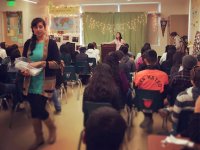Honoring Our Families’ Immigrant Narratives
Two teachers’ research and ELA unit explored students’ own family immigrant stories while creating a storytelling experience as a vehicle for empathy, community, and great writing.
Your content has been saved!
Go to My Saved Content.As we navigate a political landscape that is too often hostile toward immigrants, it's a good time to remember that the vast majority of us are here as American immigrants.
The Power of Storytelling
Recent anti-immigrant rhetoric in the news is disheartening and infuriating, and it urgently pushed us to address these issues in our high-school classrooms. As educators, we felt it was our responsibility to provide students with an outlet and counter-narrative to the dehumanization of immigrants and, recently, refugees. With this context, we wanted to create an experience in which the power of storytelling could be used as a vehicle for empathy, community, and great writing.
We are ninth-grade English and history teachers at a small California charter school that serves many first-generation students. As teachers of color and immigrants, we felt that we had a responsibility to bring these issues into our classrooms and engage in personal reflection and analysis. We jumped at an opportunity to collaborate with Elliot Margolies, founder and director of Made Into America, a non-profit organization with a mission of archiving immigrant stories. In our two-week humanities project, students investigated and wrote the immigration story of one of their family members to be published on the Made Into America online archive. The inherently authentic nature of the task lent itself to strong student investment and writing products.
More notably, the task privileged students whose families are recent immigrants or who had personally emigrated here themselves. Additionally, it gave students an opportunity to utilize their native languages in their writing and view that as an asset rather than a deficit. (How often do we get to do these things?)
Creating the Narrative
Our version of this project spanned eight instructional hours, but it's very adaptable to however you might use it in your own curriculum. We used these traditional steps of the writing process:
1. Kick-Off: Interview Workshop and Skype Call With a Syrian Refugee
Students engaged in an interview workshop where they teased out elements of a good story and developed interviewing techniques. In this workshop, they learned how to ask poignant follow-up questions to gain rich, provocative, detailed responses. For example, students learned that when the interviewee's intonation changes, or when they start to give quirky, memorable details from their journey, the interviewer should say, "Tell me more." Then, students applied and practiced these techniques by writing questions and conducting a Skype interview with a Syrian refugee who recently emigrated to Lebanon. (This step could also be done by inviting an immigrant parent or a guest as an interviewee.)
Resources:
2. Action Research: Interviewing Your Family Member
Using techniques learned from the interview workshop, students wrote questions to use for conducting interviews with their family member. Before writing their own questions, they examined an example story that one of us had written in order to understand the end goal of their interview. We encouraged students to conduct and transcribe their interview in their home language. (Note: Students with special circumstances interviewed and wrote stories of their neighbors or friends.)
Resources:
3. Organize Details: Outlining the Story
In order to guide students in their interviews, we asked them to divide the immigration story into five main parts:
- Life in original country
- Why they decided to leave
- How they left
- Arriving in America
- Where they are now and hopes for the future
We encouraged students to cover each part in their story, but emphasized that each story is unique, and that some parts would be longer than others. To organize their interview responses, students copy-pasted their interview into each part of the outline.
Resources:
4. Drafting and Workshopping the Story
After looking at one more example story from us, as well as exploring the Made Into America website, students started drafting their stories. As they wrote, we held writing workshops around writing in different points of view (POV), embedding quotations, and writing engaging hooks. We also projected and examined student work in real time throughout the writing process. Here are writing skills that we workshopped:
- Students examined POV and "tried on" different POVs (first- or third-person perspective) before settling on the one that most powerfully conveyed their story.
- Students creatively embedded non-English quotations from their interviews.
- Students experimented with different hooks as an opening for their story.
Resources:
5. Peer Review and Final Draft
Students peer reviewed and finalized their drafts.
Resources:
6. Honoring Our Immigrants: Sharing and Celebration
A few days prior to the celebration, we sent the students out with invitations and cards to give to their interviewees. The goal for this celebration was to honor the immigrants, the interviewees, and their families. During the sharing activity, students sat in a circle and shared one part of their story. With a 30-person classroom, each student got one minute to share part of his or her story. At the end, they shared overall reflections and learning experiences with one another. It was a powerful and collective way to end this project.
Resources:
Here are some examples of the stories written by students:
Has your school honored students' heritage and their families' immigrant narratives? Please tell us about it in the comments section below.
